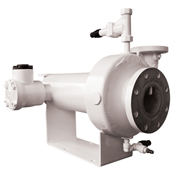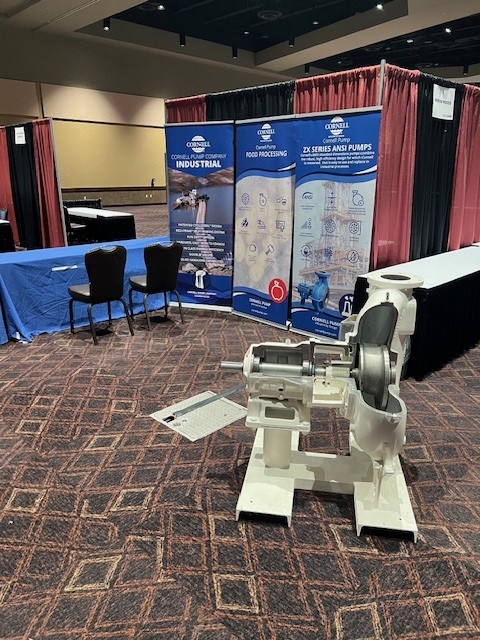Bypass Line Design and Minimum Flow Control
Centrifugal refrigeration pumps, like all hydraulics of this type, encounter recirculation at low capacity. Below one-third of the best efficiency point, secondary flow begins within the impeller, causing turbulence, vortices, and potential cavitation. Cornell specifies bypass lines between the discharge flange and the wet return to maintain minimum flow.
- Recommended line size: ≥ ¾ inch with a globe or needle valve (relief valves are unsuitable). This flow can also be controlled with Q-min orifice.
- Bypass capacity is factored into total system flow, ensuring that the pump never runs at dangerously low capacity
This simple safeguard stabilizes operation, minimizes vibration, and extends pump life.
Capacity Calculations
System flow is directly tied to refrigeration load. For ammonia (R-717), the commonly used rate of evaporation is 0.063 GPM per ton, while for R-22 it ranges between 0.17 and 0.215 GPM per ton, depending on temperature.
Cornell applies the full enthalpy-based formula:
GPM=1496.1×Tons×Recirculation Rate(hg−hf)×DensityGPM = \frac{1496.1 \times \text{Tons} \times \text{Recirculation Rate}}{(h_g – h_f) \times \text{Density}}GPM=(hg−hf)×Density1496.1×Tons×Recirculation Rate
Where:
- hgh_ghg = vapor enthalpy (BTU/lbm)
- hfh_fhf = liquid enthalpy (BTU/lbm)
- Density = refrigerant liquid density at evaporation temperature
This calculation ensures precise sizing for pumps in large liquid overfeed or transfer systems
System flow requirements are a function of BTU removal and are typically expressed in gallons per minute (GPM). A common formula used to convert from BTU removal requirements to an approximate flow rate is:
Tons of Refrigeration X Rate of Evaporation (GPM per Ton) X recirculation rate = US GPM
For R-717, the typical Rate of Evaporation, GPM per Ton, ranges from .058 at -40° degrees F. The Rate of Evaporation, GPM per Ton, of .063 is commonly used as an average for the most common range of application temperatures and allows quick and reasonably accurate calculation of flow rate without referring to published curves or tables.
For R-22, the typical Rate of Evaporation GPM per Ton ranges from .17 at -40° degrees F to .215 at +40° degrees F.
Where refrigerant properties tables are available, the required flow rate can be calculated accurately from the following formula:
GPM = [1496.1 x Tons x Recirc. Rate]/[(hg-hf) x Density], where
TONS = Total tons of refrigeration at a specified evaporating temperature.
1 TON = 12,000 BTU/HR.
Recirc. Rate = Ratio by weight of units of refrigerant liquid entering a heat exchanger to units of refrigerant gas exiting the heat exchanger.
Density = Density of liquid refrigerant at evaporating temperature in LBm per Cubic Foot.
hg = Enthalpy of vapor phase of refrigerant in BTU/LBm.
hf = Enthalpy of liquid phase of refrigerant in BTU/LBm.
Cavitation and NPSH Management
Cornell designs refrigeration pumps with careful attention to Net Positive Suction Head (NPSH).
- NPSHA: Available head at suction = static liquid height minus suction losses.
- NPSHR: Required head, dictated by impeller geometry and velocity effects.
Cornell mandates that NPSHA must exceed NPSHR by at least 2 feet to avoid cavitation. Unlike water applications, ammonia’s lower vapor volume makes metal pitting rare, but cavitation still reduces efficiency and pressure differential
Material and Flange Integrity
All Cornell refrigeration pumps are built from ASTM A536 60-40-18 ductile iron, annealed for strength at cryogenic temperatures.
- Rated to 250 psig at -20°F to 100°F.
- Null ductility transition temperature: -60°F.
- Pressure-tested to 1,000 psig static without failure.
Mechanical seal limits, not casing, set the long-term pressure ceiling (typically 200 psig for high-pressure seals)
Seal System and Oil Reservoir Technology
Cornell’s double mechanical seal system incorporates:
- Back-to-back seals with a pressurized oil barrier.
- Continuous circulation via a pumping ring.
- Limit switch monitoring for predictive seal maintenance.
Oil reservoirs use ISO 15–22 grade refrigeration oils with pour points as low as -98°F. Since 1992, a self-venting piston rod design prevents overcharging, reducing chamber overpressure and extending seal life
Drop Leg and Pump Leg Engineering
Correct line sizing is critical for gas-liquid separation and pump protection:
- Drop legs: Target 0.25 ft/sec velocity to allow vapor disengagement. Minimum submergence = 12 inches below liquid level.
- Pump legs: Sized for 3 ft/sec velocity, balancing friction loss against heat capacity. Oversizing is limited to one pipe size
Energy Efficiency Through Overfeed Systems
Liquid overfeed systems powered by Cornell pumps overcome the inefficiencies of direct expansion systems:
- Evaporators remain fully wetted, ensuring maximum heat transfer.
- Overfeed ratios of ~3:1 guarantee near-saturated vapor return, reducing compressor discharge temperature.
- The pump eliminates reliance on high compressor discharge pressure, allowing head pressure to “float” with ambient conditions — saving significant energy, particularly in cold climates
Conclusion
Cornell refrigeration pumps embody the intersection of thermodynamic optimization, hydraulic design, and mechanical durability. By focusing on flow stability, NPSH management, robust metallurgy, and advanced sealing systems, Cornell provides pumps that deliver consistent performance and measurable energy savings in demanding industrial refrigeration environments.




